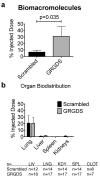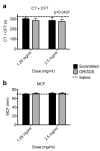Intravenous hemostatic nanoparticles increase survival following blunt trauma injury
- PMID: 22998772
- PMCID: PMC3496064
- DOI: 10.1021/bm3013023
Intravenous hemostatic nanoparticles increase survival following blunt trauma injury
Abstract
Trauma is the leading cause of death for people ages 1-44, with blood loss comprising 60-70% of mortality in the absence of lethal CNS or cardiac injury. Immediate intervention is critical to improving chances of survival. While there are several products to control bleeding for external and compressible wounds, including pressure dressings, tourniquets, or topical materials (e.g., QuikClot, HemCon), there are no products that can be administered in the field for internal bleeding. There is a tremendous unmet need for a hemostatic agent to address internal bleeding in the field. We have developed hemostatic nanoparticles (GRGDS-NPs) that reduce bleeding times by ~50% in a rat femoral artery injury model. Here, we investigated their impact on survival following administration in a lethal liver resection injury in rats. Administration of these hemostatic nanoparticles reduced blood loss following the liver injury and dramatically and significantly increased 1 h survival from 40 and 47% in controls (inactive nanoparticles and saline, respectively) to 80%. Furthermore, we saw no complications following administration of these nanoparticles. We further characterized the nanoparticles' effect on clotting time (CT) and maximum clot firmness (MCF) using rotational thromboelastometry (ROTEM), a clinical measurement of whole-blood coagulation. Clotting time is significantly reduced, with no change in MCF. Administration of these hemostatic nanoparticles after massive trauma may help staunch bleeding and improve survival in the critical window following injury, and this could fundamentally change trauma care.
Figures





References
Publication types
MeSH terms
Substances
Grants and funding
LinkOut - more resources
Full Text Sources
Other Literature Sources
Medical

